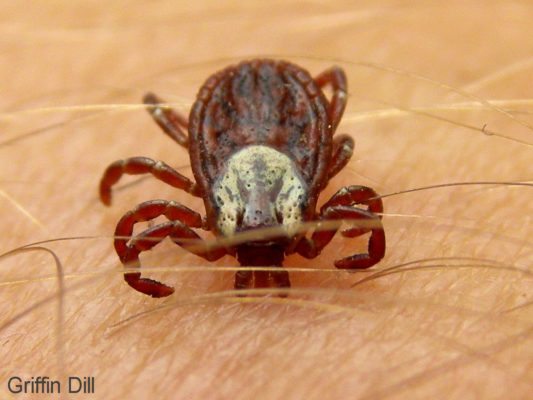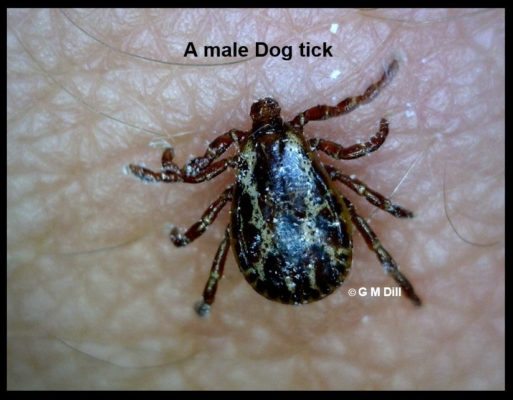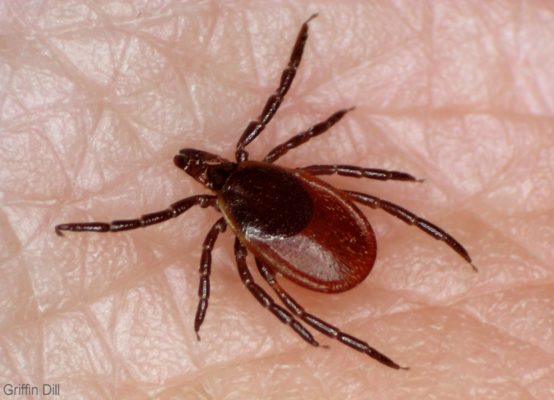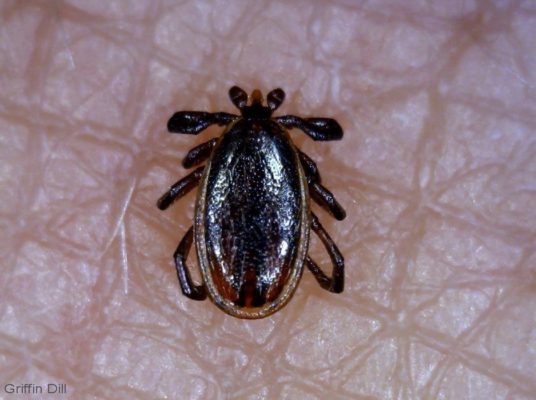Can you identify a Deer Tick?
Everyone living in Westchester needs to be able to identify a deer tick, even if you do not spend a lot of time outdoors. Know the difference between the deer tick which carries Lyme disease, and a dog tick, which does not carry the disease.
The stages of Ixodes scapularis, the black-legged or deer tick: larva, nymph, adult.
A female black-legged deer tick, Ixodes scapularis.
A male deer tick
Top Row: Dermacentor variabilis, the American dog tick, which is not thought to transmit Lyme disease. Left to right: adult male, adult male dorsal side, nymph, larva. Adults are most common in May, June, and July. Note that the adult dog ticks are somewhat larger than adult deer ticks, and have characteristic white markings on the dorsal (top) side.
Bottom Row: Ixodes scapularis (dammini), the deer tick which transmits Lyme disease. Left to right: adult female, nymph, younger nymph, larva. Nymphs are most common May through July. Adults appear in the fall and early spring.
An adult deer tick (left) and an engorged deer tick filled with blood (right).
An American dog tick
A “Tick”ing Time Bomb
Have you ever felt The Fear? Have you ever felt the gripping, nauseating fear that comes with finding a tick burrowed into your skin? Aside from the obvious ickiness of having an arachnid bite you, the fear of the disease that can be spread by ticks is very real, and the results can be debilitating. It is almost impossible to think about ticks and not think about the dreaded “L” word; Lyme disease. Yet, as with most things, knowledge is power.
Despite the popular opinion that there are only Deer Ticks and Dog Ticks in Northern New England. There are actually over 14 different species of ticks in Maine alone. These include the:
- Bird Tick
- Kennel Tick
- Lone Star Tick
- Mouse Tick
- Rabbit Tick
- Seabird Tick
- Squirrel Tick
- Woodchuck Tick
- Winter (or Moose) Tick
Fortunately, most of these ticks do not transmit diseases to humans. Lyme disease has been shown to be spread primarily through the Deer Tick, which is also known as the Black-Legged Tick. It has been estimated that up to 25% of all Deer Ticks nymphs‘ (immature ticks) and up to 50% of adult Deer Ticks are carriers of Lyme Disease.
However, ticks can appear similar to the untrained eye. so it is still critical that we be able to differentiate between the types, as there are other diseases and infections that can be spread beside Lyme.
Dog Ticks
Adult Dog Ticks are about 1/4 inch long, however, the males are typically a bit smaller.
Female
A key feature between males and female dog ticks are the intricate hexagonal dark area above the head of a female.

Male
Male dog ticks attach themselves, but they do not become engorged like the females.

Deer Ticks
Adult Deer ticks are about the size of a poppy seed and can be very hard to see.
Female
Females deer ticks are brown to reddish-orange, with a dark brown/black area behind their head.

Male
Male deer ticks tend to be dark brown without the reddish tones and are slightly smaller than females.

Tick Facts
Although we tend to think about ticks only in the summer months, primarily May through August when they are most active, ticks can actually live through the winter and will remain active through much of the year. They can burrow into leaf litter and survive quite nicely until temperatures warm up to a more suitable level. The bite of a tick is often painless, so unless you discover them attached while doing a tick-check, the first indication you may have is a rash over the affected area.
Tick rashes can come in a variety of shapes and sizes, and are not always at the site of the bite. They can range from the classic “bullseye” too big blotches of red. In some cases, they many not even show up at all.
In the event that you see any of these types of rashes, seek medical attention immediately. Lyme is very treatable, especially if caught early. Ignored, it can be debilitating. If you, your family, or your furry four-legged family members encounter ticks on your property, give us a call at Modern Pest Services. Let us treat your yard for ticks, (as well as mosquitos), creating a barrier of protection for you and your loved ones. Enjoy your summer without worry!
Do you still have The Fear? Maybe you do – take comfort because we know how to squash that fear like a bug!
Special thanks to the Center for Disease Control and the UMaine Cooperative Extension: Insect Pests, Ticks, and Plant Diseases, in Orono, ME, for their photos and information.
The Modern Difference
If you find yourself waging war against ticks, Modern Pest Services can help. Our Mosquito & Tick Control provides two services for the price of one! Our program consists of 5 monthly treatments between May and September and has been proven to effectively reduce both tick and mosquito populations – guaranteed!